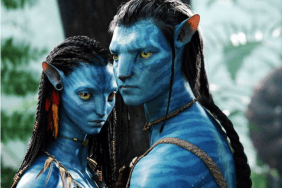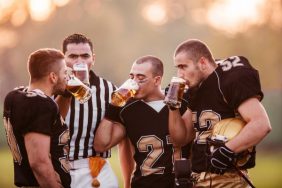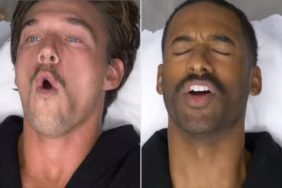The Hobbit: An Unexpected Journey features many new creatures from the Tolkien world, brought to life by the same team that made The Lord of the Rings trilogy, and reintroduces new and improved versions of some familiar favorites. We got to meet up with Academy Award winning visual effects supervisor Joe Letteri in his hotel room during a trip to Los Angeles before The Hobbit opens this Friday, December 14. Some spoilers for key scenes of the movie follow, but assuming you’ve read the book and are eagerly anticipating every scene, you should be safe.
CraveOnline: I was watching the Lord of the Rings DVD extras to prep for this, and it was extraordinary to see what you guys accomplished on the Pelennor Fields sequence. Was there an equivalent sequence on The Hobbit?
Joe Letteri: Probably the goblin caverns because like Pelennor Fields, we sort of had to create this whole environment for that battle to happen in, and the goblin caverns was similar for us. We saw the ideas for the designs. [Conceptual designer] Alan Lee did this little sketch of a bunch of goblins living on the side of the cave walls with pieces that they had scavenged from their raids out in the real world and Peter [Jackson] took that and said, “Yeah, I like that.” It developed into this whole big cavern that to me was almost like an inverted city. You go and the king’s just in the middle of it but the whole city’s all around you. So you’ve got three dimensions that you can move through which was great because we were shooting in stereo. We knew we could build that and have these opportunities to fly the camera not only in and out but up and down. We had to go in and just shoot little pieces of it with the actors and then just put them in the middle of this big enormous stage. So very similar to Pelennor Fields in that way but now much more three dimensional and as I said, sort of inverted.
More three dimensional as in there are levels of the cave, versus the one level flat plane.
Exactly, one level. Three dimensional as opposed to stereo, viewing with two eyes as opposed to moving through space three dimensionally.
Like 10 years ago, did you take a series of reference photos for the goblin caverns?
Well, not for the goblin caverns because it didn’t exist. The only thing that would exist would be a little bit of a platform or a bridge that the guys could run across or have their dialogue scenes with. The rest of it we made up.
How long did the goblin sequence take?
About a year to do.
Was that one of the first things you started on?
It was actually, yeah. And one of the last things we finished.
At the point where you started pre-vising and developing that sequence, was that always intended for “Movie 1,” or did that move around too?
No, that was always intended for Movie 1.
How did the actual Goblin King with that chin jowl develop?
That was an idea that Peter had and I think that might’ve been one of the Guillermo [Del Toro] influences coming through because Guillermo was really interested in pushing the bounds of the characters beyond what we’ve seen in the Rings film. Obviously he has his own sort of sensibility to that. I think Peter liked the same idea. Obviously they were collaborating on those designs early on, but it was something that Peter just really wanted to make him disgusting. He just wanted, when you first see this guy, obviously he dominates by his sheer bulk and size because physically he’s just much bigger than all the other goblins, but he just wanted it to be really unpleasant.
Did you develop anything with Guillermo del Toro when he was on the project to direct?
Well, we went through all the development with Guillermo for all the characters, the goblins and all the different designs and so forth, but they all got revisited once Peter decided that he would come on board as a director after Guillermo left, including the script itself. The script itself went through a rewrite just to focus a little bit more on some of Peter’s sensibilities, which I think was leaning a little bit more towards some of the moments between the characters, similar to the way those relationships developed in the original trilogy, in Lord of the Rings.
So how much preproduction work had to get scrapped and how much of it could be modified?
That’s a very good question. A lot of the preproduction work that got changed was design work. So it was mostly what Weta Workshop had done. By the time we really got on board in full, Guillermo had already left and Peter had taken over the project, so by the time we got started on the digital side and actually making the designs that you were going to see in the film, it was all new designs by and large.
Can you even start working until Weta knows what the characters and creatures are going to be?
It helps but usually we start with some version of it because it’s an exploration process. To us, getting a design for a character or a creature, whether it’s a piece of artwork or a maquette is very similar to handing a script to an actor. It’s the bones of what it’s supposed to be but the interpretation still comes alive once we start working with the character and seeing it up on screen and really finessing it and see how it works through different kinds of performance or different angles or different lighting, whatever the case may be.
Would you pre-vis the goblin sequence with rough goblins before you knew exactly what they’d look like, but you’d have the action choreographed?
Yeah, that’s exactly right. We had some idea based on Workshop designs of what they should look like. We made low resolution models but mostly you’re not focused so much on the design when you’re doing pre-vis. You’re focused more on the performance and the storytelling. And even performance, not exactly because you don’t really have the actors’ performance but things like if you know the Goblin King is going to be much more massive than the goblins, that does influence how you’re staging things.
Isn’t it great that we can talk about pre-vis and maquettes and everyone knows what we’re talking about because they’ve seen the DVDs?
It is. It’s really great because this whole process for us really transpires across the whole length of the filmmaking process. Where visual effects used to be considered post-production, now it actually starts with preproduction, working with the character design. You’re there all the way through the shoot. Simultaneously you’re dealing with what needs to happen on stage to make everything work, what you’re trying to capture via green screen or performance capture and you’re also pre-vising all the way through the production and you’re building characters and designs and assets, and you’re putting shots into production. So it’s all happening at multiple levels simultaneously.
My favorite new creature was little Sebastian.
The hedgehog, yeah.
What can you tell us about creating him?
He was in a way fairly straightforward. There was some thought given to the idea early on that maybe he would be animatronic because you could easily rig him to where Sylvester McCoy could be holding him, but we also knew that to really get that alive, spirited, nuanced performance that we would just eventually do him as a digital character and so he was done entirely as a digital character and the performance is really driven by our animators. Peter talked to them about what he wanted and how they would play off of Sylvester’s performance, but it was done as just a pure animation piece.
Does 48 frames per second give you twice as much work to do?
Yes and no. You have to create twice as many frames in the end and some areas of the work require twice as much work: rotoscoping, camera tracking, paint, that sort of thing. Animation sometimes needs more work, sometimes it doesn’t. Lighting’s barely affected by it but your rendering of course is twice as much so in the end you’re producing four times as many frames as you normally would because you’ve got stereo and then you’ve got 48 frames, but it’s not exactly twice as much work. It’s somewhere in between.
But it’s more. We’ll just say it’s more.
It is more, yes it is.
The DVDs from Return of the King, it shows how Peter came up with the moment where the elephants crash into each other. What are the signature moments of An Unexpected Journey he came up with and gave you to execute?
I was going to say, in a way they’re all Peter’s moments that he comes up with. I’m trying to think if there are any that were ideas that we might’ve thrown this way that he picked up. I know there were a few but I’m not thinking of them offhand. Most of them are ideas that Peter’s come up with. In the sequence of the stone-giants, the thunder-battle, we did throw some ideas his way on that one because the brief was to stage a fight, and we just kept trying to come up with different ways of staging the fight so it didn’t just look like two guys in a suit punching each other. That was a lot of back and forth collaboration on that one.
What were the signature, difficult moments to achieve in the goblin battle, the stone-giants, or the Moria flashback?
Oh, there were lots of them. In the stone-giants, because they’re made of rock, we needed to come up with a clever way to layer the rock and design it so that they could still articulate because they’re made of solid pieces but they needed to be very flexible to fight. And then staging the battle so that, again, we had an interesting way of them fighting. Coming up with the idea that one of the guys would head butt the other and the head would explode, just coming up with things like that that were more what you could do with rocks as opposed to actors throwing punches at each other. The Moria battle was really just the size of it. We just had these huge armies but we needed to come up with ways to keep it alive because most of the battles back on Rings, there was always some element on horseback. You could add dynamics because these guys were constantly charging back and forth. Here we had a battle that took place largely on foot so we had to just choreograph waves of motion throughout the battle so that there were some interesting dynamics in the field because once the two sides meet, you’re just standing in place fighting essentially. The goblin caverns I already talked about. The big notes there were just trying to move through almost like a Chutes and Ladders landscape. You wanted to feel the goblins were just coming at you from every direction no matter what was happening and that they could go away in any direction.
But to give everyone something to do in the background, even give every computer generated character something to do.
That’s exactly right. You could never have someone standing around waiting for things to happen, which on a live-action set might happen. If you have enough extras, you might get in the shot one or two of them not knowing what to do and the action goes a little bit flat. Here we had to make sure that every bit of action on the screen was choreographed and was focused towards the main action of the shot.
Did extending The Hobbit into a trilogy add a lot more visual effects shots for you?
It did surprisingly. We thought it was going to be less because we thought, okay, now certain things are going to move into the second film or the third film. We could spread it out a little bit but one of the things we didn’t know at the time was the reason we were taking it to three films was to tell more of the story, like the prologue and the Moria battle suddenly became something that we had to get into the first film.
So that wouldn’t have been in the film if it were only two parts?
Maybe a shorter version. If you needed to get more of the story into just two films, everything would’ve had to have been shortened a little bit.
So it ramped things up for the first film, not only adding an extra third part.
It did, exactly, yeah, which if you think about it, that’s to be expected. The whole reason you’re going to three films is to tell more of the story.
It is, but at the point they decided to do the third film, the first film might have been pretty much locked and you extend the second one into the third.
At the time it was decided we knew it wasn’t exactly locked. The main unit was just finishing shooting. We knew there was more to come because Peter hadn’t had a chance to cut everything at that point, but we didn’t realize exactly how much of that first story was going to get expanded and told. When you think about it, it was really necessary to set up that story because you really need to establish what the dwarves lost and what it is that they’re after. In the books, they just sort of tell you what happened but in a film you need to experience that sense of loss and that sense of defeat.
Moria we’ve seen before. Were you conscious of trying to do different things with it here?
Mm-hmm. We were. It was completely rebuilt. Alan Lee and [conceptual designer] John Howe did the designs for it. Obviously with the earlier designs in mind but in Lord of the Rings, it was so far into the future and it was so far gone that we really only paid attention to the bones of it, the outlines of it. Here we were really trying to establish that it was an underground kingdom, that it was vast, that it was wealthy and that it extended deep into the earth. The mining of the metals and the making of the jewelry was just integral to the form. The idea we really tried to portray here was starting from the gate and the statues that you see outside, is that all of this was carved right from the stone of the mountain. None of this was quarried and brought in, but it’s all part of the mountain itself.
We’ve seen trolls before too. How did you want to approach them differently in The Hobbit?
We always approach the trolls differently. If you go back and look at the Lord of the Rings trilogy, the trolls in each of the three films are different. We always treated them as if there’s some different tribe or clan of trolls, so this was yet again a fourth variation of the trolls. The main thing for us here is they needed to speak so we needed to just really come up with interesting faces for them that didn’t just look like actors in suits but could still carry dialogue, so we did strange things with their eyes to pull them apart and give one of them a lazy eye, but really here the performance and the dialogue were really what was important.
We haven’t heard them speak before?
No, in the other films we don’t hear them speak. They grunt and everything but they were pretty much big powerful beasts in a way.
What about Radagast on the rabbit sled?
That was an idea, because he’s the wizard who’s caring for the forest and caring for nature, Peter wanted something that was sort of holistic with that approach. What would he use to pull his sleigh around? Horses are obvious but horses don’t live in the forest by themselves so what else could he use? Someone had found these pictures of these giant rabbits that I guess are German. In Germany they have huge rabbits so we looked at those and said, “Yeah, we make those a little bit bigger, they could probably pull a sleigh around.” So that was our model.
There’s a number of giant real world animals, like the wolves and the hawks also. Were real life animals useful in all three cases?
For reference. The only time we actually used real live animals in the film itself was the ponies who are dressed up in these pony suits anyway to look more like northern ponies, the very long-haired ones, and obviously you saw a couple of farm animals running around Dale and Hobbiton. But the other animals like the wargs and the eagles, we looked at reference but we made those all as digital creations.
Have there been improvements to digital doubling technology in the last 10 years?
There have. All the work we’ve been doing in the past 10 years to create characters, from what we started with Gollum and what we’ve learned from there, carrying through the Na’vi in Avatar or even the characters we did for Tintin because they were very humanistic, has all been applied to digital doubles and we’ve also been doing digital doubles throughout the years as well. Any time we have a really impossible stunt, we’ll turn to a digital double. In The Hobbit we actually used digital doubles quite extensively because if you think about any of the dwarf characters for example, you’d have the main actor who’d be playing the dwarf. Then you’d have their scale doubles and you’d also have their stunt double and then you’d have their digital double. So any shot of a dwarf could have any one of those variations of the dwarf be what you see in camera. For us it became a question of do you really need to do something a human actor can’t do or the stunt performer can’t do? In which case you just go to a digital double right off the bat, or sometimes especially in the goblin caverns, some of the scenes got so complex with what was shot. All the goblins [were] shot in sort of a half costume with no heads, with the idea that we might replace their heads later on, but because they were just crawling all over these dwarves in some of the shots, sometimes we’d just have to replace everything. As long as it was an action scene, they weren’t delivering dialogue or anything that you could really tell, it was fine. We could get away with it.
We’re all waiting to see more of Smaug. What Smaug sequences are you looking forward to doing?
We don’t actually know yet. We haven’t seen what those are going to be. We’ll have to catch up on that next year.
At this point, that’s still in flux?
We haven’t got a final cut on it yet, although we’re starting to work on film 2 so we’ve got cuts on some of the scenes, but not those yet.
Well, the title is The Desolation of Smaug so we expect something.
You should get ready for it, huh? Okay.
What have you started doing for Film 2?
Let’s see. I probably can’t talk about film 2 yet. Let me just hold off on that one.
Since you’re going to be in The Hobbit for the next two years, are you able to work on any other films?
Oh yeah, we’ve got a number of other films. Currently we’re finishing up some work on Superman for Zack Snyder. We’ve got a little bit of work we’re doing on Iron Man 3 right now and also Wolverine. Then there’s a couple of other films that we’re waiting for green lights on that we’re hoping to be starting soon.
By the time Mr. Cameron’s ready to do an Avatar sequel, do you expect you’ll be available?
Oh, absolutely. Absolutely. We continue to work out ideas in preproduction for Avatar so whenever Jim is ready to go, we’ll be ready as well.
He wants to go 60 frames, right?
That was his latest thinking, yeah. I did talk to him. He’s seen the 48 frames and I know he really liked that and he thought it was successful and working well, so that was great, but I haven’t talked to him on whether he thinks that that’s actually sufficient with where he wants to go or if he’s still inclined to go 60. Probably still inclined to go 60 just because you just get even closer to having that visual veil disappear between what your human eyes can perceive and what you can project.
Are you ready to go that far if need be?
Yeah, that wouldn’t be a problem for us. We know how to do it. We know how to handle high frame rate so it’s really just sort of a creative decision.
Without spoilers, what challenges did Man of Steel give you?
Can’t talk about that one at all. Not at all.
Which of the shots in the Iron Man 3 trailer are yours?
Can’t talk about Iron Man 3 either at all. We’re just too early days on those.
What bonus features are you working on for The Hobbit: An Unexpected Journey?
Can’t talk about that either.
Really, the DVD stuff?
No. I’d actually have to know more than I do to talk about that, but yeah.
Is making Gandalf big in Bilbo’s home different now than it was on the original trilogy?
Yeah, because we couldn’t use forced perspective as much as we could in the past. I mean, really hardly at all. If the camera wasn’t moving, you could get away with putting Gandalf closer to the camera and Bilbo farther away, especially because we could then chop Gandalf out of the frame and blow him up and still give you the proper perspective. But because the idea is to keep the camera moving as much as possible, we actually had to do moving forced perspective. So we actually had to synchronize two sets of cameras at two different scales, one shooting the dwarves and one shooting Gandalf, lock the two together and have them simultaneously be feeding their signal to the monitors so that Peter could see everything composited together and direct the shots that way. Yeah, a lot of the old fashioned tricks just go away when you had stereo.
Is it because of the 3D or the moving camera?
Because of the 3D. Forced perspective depends on you having just one perspective line and in stereo, you have two to start with, and as soon as you start moving the camera it just breaks. So you have to take the same idea but rather than just saying okay, this camera is locked and these two objects are locked, you have to maintain that perspective difference as the cameras move and as the actors move. So it’s all done dynamically.
Were you able to do more with Gollum in his scene?
Yeah, absolutely. He’s kind of a complete rebuild from what we did 10 years ago. Much more detail has gone into creating him and what we can put up on the screen is just much more nuanced than we could ever do 10 years ago. Plus Andy [Serkis]’s performance now is what he did on the day. 10 years ago, he would have to come back a few months after we shot it and recreate his performance on a motion capture stage and we’d have to take that and fit it into the shots. Here, we captured him live as he was performing with Martin and that performance is directly what you see in the film.
Fred Topel is a staff writer at CraveOnline. Follow him on Twitter at @FredTopel








